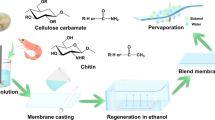Conclusions
-
The effect of dipolar aprotic substances (urea or acetone) and also of protogenic molecules (acetic acid) or of the protophylic acetate ion on the optical and rheological properties of cellulose triacetate spinning solutions has been examined.
-
It has been established that protolytes and dipolar aprotic substances in definite quantities aid in deaggregation of the microgel particles and reduce the viscosity of the spinning solution. Thereupon, the protolytes exert a greater effect on the viscosity of the spinning solution than the dipolar aprotic solvents.
Similar content being viewed by others
Literature cited
V. N. Smirnova and M. M. Iovleva, The Turbidity Spectrum Method in Investigating Solutions of Fibre-Forming Polymers [in Russian], NIITÉKhIM, Moscow (1986).
G. P. Denisova and S. E. Artemenko, Khim. Volokna, No. 5, 33 (1985).
A. K. Dibrova, V. B. Glazunov, and S. P. Papkov, Khim. Volokna, No. 3, 21 (1986).
S. Yu. Shchegolev and V. I. Klenin, Vysokomol. Soed., Ser. A,13, No. 12, 2809 (1971).
Additional information
Translated from Khimicheskie Volokna, No. 1, pp. 19–21, January–February, 1992.
Rights and permissions
About this article
Cite this article
Denisova, G.P., Artemenko, S.E., Ustinova, T.P. et al. Multicomponent solvents for cellulose triacetate. Fibre Chem 24, 24–28 (1992). https://doi.org/10.1007/BF00557173
Issue Date:
DOI: https://doi.org/10.1007/BF00557173




